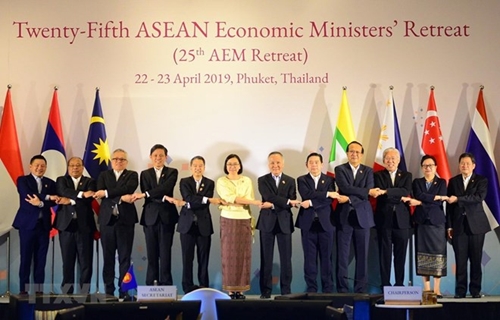Once the negotiations are successful, the RCEP will become the biggest multilateral trade deal involving 10 ASEAN countries and China, India, Japan, the Republic of Korea, Australia and New Zealand, making up 29 percent of the global GDP and 30 percent of world trade value.
Meanwhile, the ASW aims to unify the single window systems of ASEAN countries for faster customs clearance and more simple procedure for trans-national trading. Thanks to the ASW, the waiting time for goods in the border can be reduced to only three days instead of 10.
    |
 |
|
Participants at the 25th ASEAN Economic Minister Retreat (AEM Retreat) |
At the two-day event, the ministers are scheduled to sign two important documents – the ASEAN Trade in Services Agreement (ATISA) and the fourth protocol amending the ASEAN Comprehensive Investment Agreement (ACIA).
According to Auramon Supthaweethum, head of the Trade Negotiations Department of Thailand, the ATISA is meant to reduce unnecessary barriers for the service sector in the region and to strengthen transparent in regulations for each ASEAN country. It will benefit services in healthcare, tourism, accommodation, construction, convention and exhibition services.
At the same time, the ACIA will focus on dealing with issues given by governments to foreign investors to promote regional investment cooperation.
ASEAN countries concluded negotiations for the two deals in late 2018.
As ASEAN Chair 2019, Thailand will focus on three major contents covering 13 economic priorities, including ASEAN Support to prepare for the fourth Industrial Revolution, connectivity enhancement and sustainable development, she said.
Two-way trade between Thailand and ASEAN grew by 13 percent to 114 billion USD last year. ASEAN accounted for 27 percent of Thailand’s exports. Thai statistics show that Thailand’s trade with RCEP countries reaches nearly 70 billion USD. Thailand’s exports to RCEP countries account for 58 percent of the country’s total export revenue.
Source: VNA